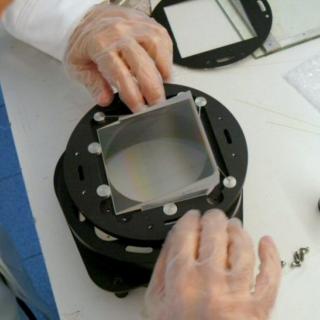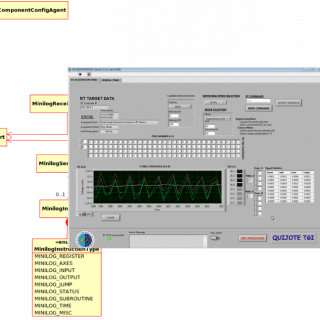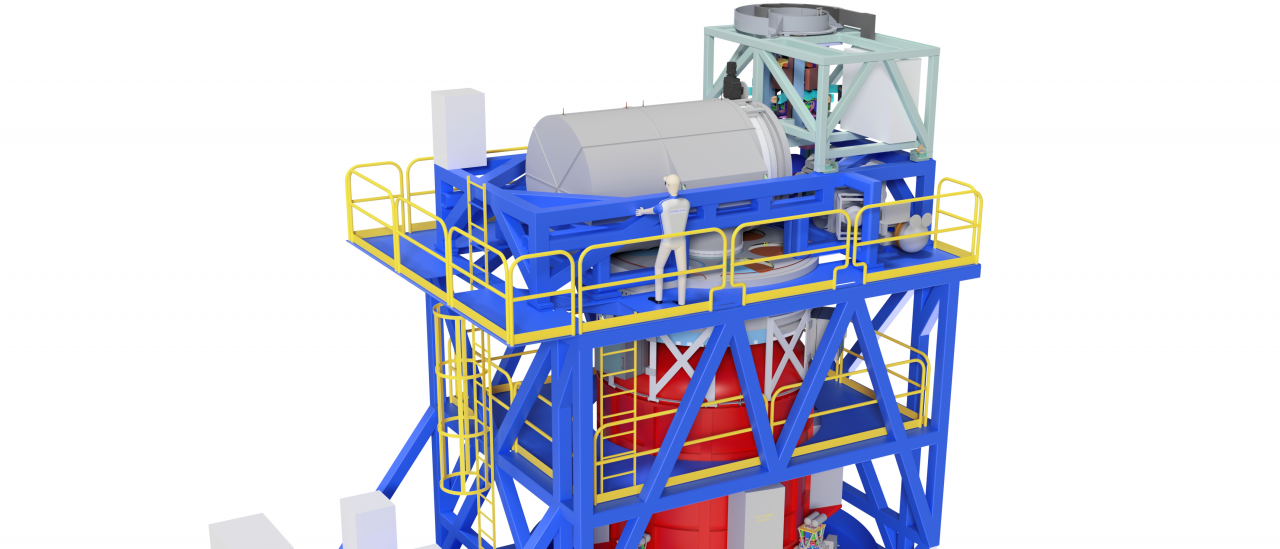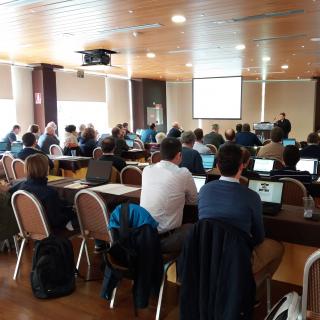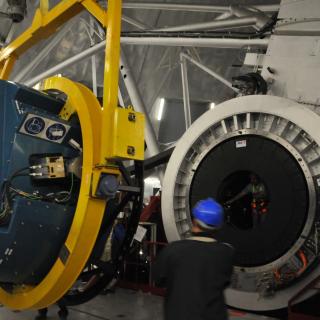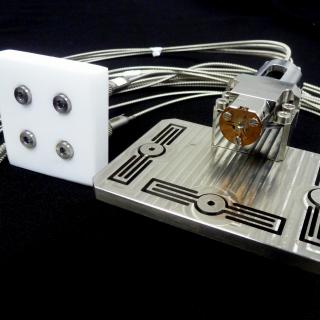Grants related:
General
HARMONI is a visible and near-infrared (0.45 to 2.45 µm) integral field spectrograph, providing the E-ELT's core spectroscopic capability, over a range of resolving powers from R (≡λ/Δλ) ~ 4000 to R~20000. The instrument provides simultaneous spectra of ~32000 (8000) spatial positions arranged in a rectangular field. HARMONI provides four spatial scales, allowing the user to optimally configure the instrument for a wide range of science programs (ultra-sensitive, diffraction limited or spatially resolved, physical, chemical and/or kinematic studies of astrophysical sources). The coarsest scale is suited to seeing limited observations and the finest is Nyquist sampling the diffraction limit of the ELT at near-infrared wavelengths. With its range of scales, HARMONI can easily adapt to adaptive optics (AO) systems; indeed it is designed to work with GLAO, LTAO and SCAO, or even with no AO at all! HARMONI is conceived as a workhorse instrument, addressing many of the key ELT science cases. It will exploit the ELT's scientific niche in its early years, starting at first light. At close-to-diffraction limited scales, it will capitalise on the D4 sensitivity gains of the E-ELT, providing unprecedented improvements in sensitivity and spatial resolution and transforming the landscape in observational visible and near-infrared astronomy. Even in seeing limited conditions (or when AO cannot be used to provide high Strehl ratios), HARMONI provides impressive gains with respect to the current generation of VLT instruments, e.g. a gain of ~25 in speed relative to MUSE at the ESO-VLT. HARMONI will have a high complementarity and synergy with ALMA and JWST, with similar angular resolution to the former and comparable sensitivity to the latter. HARMONI is an instrument concept already selected for first-light and, therefore, it will be available as soon as the ELT enters into operation. The Instituto de Astrofísica de Canarias (IAC) has been actively participating during its conceptual design phases (i.e. Phase-A and delta-A) as part of an International Consortium led by the University of Oxford (PI), and also formed by UKATC-Edinburgh, CRAL-Lyon, ONERA and Centro de Astrobiología (CAB-CSIC). The IAC contribution is about 15% of the HARMONI’s development, mainly centered on its pre-optics and the control electronic of the whole instrument. HARMONI represents an unique scientific opportunity for the Spanish astronomical community, allowing the access to the ELT as soon as it enters into operation via the guaranteed time. It also permits to the Spanish technological centres and industry to participate in the development of this advanced instrument.
Members
Results
Milestones
- 2016-2017: Preliminary design phases
- 2015: Agreement Signed for E-ELT HARMONI Instrument
- 2014: Spain commits its participation in the ELT
- 2010-2015: Redesign of ELT (42m --> 39m) => Redesign of HARMONI
- 2010: HARMONI selected as first light instrument
- 2008-2010: Conceptual design of HARMONI (Phase-A)
- 2007: First HARMONI proposal (IAC and CAB / CSIC proponents) and creation of the HARMONI Consortium
Contributions to technical conferences (including SPIE)
- Oral contribution: The E-ELT first light spectrograph HARMONI: capabilities and modes; Thatte, N. et al. (including García-Lorenzo, B., Mediavilla, E., Herreros, J.M.,Rodríguez-Ramos, L.F., J., Hernández, E., Cagigas, M., & Gigante, J.V.); SPIE Astronomical Telescopes + Instrumentation 2016
- Poster: Development of cryogenic components based on COTS parts for the HARMONI instrument; Gigante, J.V., Hernández, E., Rodríguez-Ramos, L.F., Estévez, C., Moreno, A.F., Garcia-Lorenzo, B., Herreros, J.M., Mediavilla, E., Bryson, I., Clarke, F., & Thatte, N.; SPIE Astronomical Telescopes + Instrumentation 2016
- Oral contribution: HARMONI: the first light integral field spectrograph for the E-ELT; Thatte, N. et al. (including García-Lorenzo, B., Mediavilla, E., Herreros, J.M.,Rodríguez-Ramos, L.F., Sánchez-Capuchino, J., Hernández, E., Bueno-Bueno, A., & Gigante, J.V.); SPIE Astronomical Telescopes + Instrumentation 2014
- Poster: Optical and mechanical design of the fore-optics of HARMONI; Sánchez-Capuchino, J.; Hernández, E.; Bueno, A.; Herreros, J. M.; Thatte, N.; Bryson, I.; Clarke, F.; Tecza, M.; SPIE Astronomical Telescopes + Instrumentation 2014
- Poster: HARMONI instrument control electronics; Gigante, J.V., Rodríguez Ramos, L.F., Zins, G.; Schnetler, H., Pecontal, A., Herreros, J.M., Clarke, F., Bryson, I., & Thatte, N.; SPIE Astronomical Telescopes + Instrumentation 2014
- Poster: Conceptual design of a cryogenic pupil mechanism with continuous complex movements for HARMONI; Hernández, E., Rodríguez, L.F., Gigante, J.V., Tubío, O., Moreno, T., Sánchez-Capuchino, J., Herreros, J.M., García-Lorenzo, B., Mediavilla, E., Thatte, N., Bryson, I., Schnetler, H., Clarke, F., & Tecza, M.; SPIE Astronomical Telescopes + Instrumentation 2014
- Invited Talk: Spanish Participation in the development of HARMONI, a first light instrument for the European Extremely Large Telescope; García-Lorenzo, B. & the HARMONI team; XI Reunión Científica de la SEA (2014)
Contributions to scientific conferences
- Invited review: Stellar populations in the scientific landscape of the ELTs, Battaglia, G., EWASS2019 Special Session 12: Stellar populations in the era of ELTs: advances over the next decade and beyond, Lyon, France
- Oral Contribution: Black hole-galaxy scaling relation evolution from Z~2.5: Simulated observations with HARMONI on the ELT (No 314), García-Lorenzo, B., Monreal-Ibero, A.. EWASS2019, Symposium 2: Quasars in cosmology, Lyon, France
- Oral Contribution: Simulated QSO observations with HARMONI on the ELT: Black hole-galaxy scaling relation evolution from Z 2.5 (No 315), García-Lorenzo, B., Monreal-Ibero, A.. EWASS2019, Special Session 31: 3-D spectroscopy from sub-mm to X-ray: the promise of Athena in the 2030s multiwavelength context, Lyon, France
- Poster: HARMONI view of high-redshift QSO hosts, García-Lorenzo, B. Monreal-Ibero, A., Mediavilla, E. Encuentro RIA-SpaceTec: Instrumentación astronómica en España, Madrid, Spain
- Oral contribution: Simulation of QSO observations with HARMONI, Monreal-Ibero, A., at IAUS 347, Early Science with ELTs (EASE), XXX IAU General Assembly, Vienna, Austria
- Oral contribution: From the inner Milky Way to Local Volume galaxies: resolved stellar populations with ELT-HARMONI; Gonzalez, O., & Battaglia, G. at IAUS 347, Early Science with ELTs (EASE), XXX IAU General Assembly, Vienna, Austria
- Poster: HARMONI view of high-redshift QSO hosts, García-Lorenzo, B., Monreal-Ibero, A., Mediavilla,
E., at Are AGN special? The environmental dependence and global impact of AGN activity, Durham, UK
- Invited talk: Chemo-dynamics of galaxies from resolved stellar populations with HARMONI, G. Battaglia; Early E-ELT science: spectroscopy with HARMONI, Oxford, UK
Scientific activity
Related publications
No related publications were found.Related talks
No related talks were found.Related conferences
No related conferences were found.Severo Ochoa
HARMONI is an optical/IR integral field spectrograph, chosen as a first light instrument on the E-ELT. The IAC is designing the pre-optics and the electronics of the instrument. The Severo Ochoa programme will fund the infrastructure which the IAC needs to cover the commitments acquired for HARMONI, and to carry out the required cryogenic tests. These infrastructures will be useful for all projects at the IAC which need cryogenics, and will thus put the IAC in a position as centre of reference in the development of cryogenic systems. The participation in HARMONI is a unique scientific opportunity for IAC researchers.
![Teacup in [O III] and CO(2-1) Supermassive black holes modify the distribution of molecular gas in the central regions of galaxies. Credit: HST and C. Ramos Almeida.](/sites/default/files/styles/crop_square_2_2_to_320px/public/images/project/teacup_english.001.jpeg?itok=dF4bDw-q)

